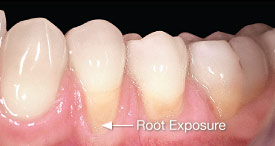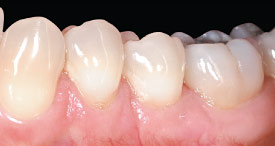Periodontal Plastic Surgery
Treating Gum Recession With Gingival (Gum Tissue) Grafting
(Continued)
Creating Or Regenerating Gum Tissue
Research into tissue genetics has built up a vast body of knowledge about tissue manipulation and wound healing. In fact, the predictable creation of gingival tissues has been understood since the 1960s.
Free Gingival Grafting — In this technique, a very thin layer of skin is taken from the palate, or other sites, in which the tissues are identical to gum tissue. Grafts are taken and shaped from the donor site and transplanted to the recipient site to create new gum tissue; both sites will heal in a very predictable and uneventful manner. The free gingival graft is so-called because it is “freed” from the donor site completely.
Free gingival grafting involves taking two layers of tissue, the epidermis (“epi” – around, outer layer; “dermis” – skin) and dermis (the layer just beneath the epidermis) together in a graft about 1mm or less in thickness, in essence a little more than a shaving of skin. The donor site, usually in the palate, feels like a burn, which can be protected by a thin plastic shield, generally only needed when eating. When graft material taken from the palate is minimal (in thickness), so too is discomfort and healing time. Both donor and recipient sites heal within 14 - 21 days. Allografts can also be used for gingival grafting to create new gum tissue without using tissue from the palate.
Connective Tissue Grafting — Connective tissue grafting is used to cover exposed roots in the treatment of gum recession. It involves delicate and sophisticated microsurgical techniques to prepare both the donor and recipient sites, constituting a true plastic surgical repair. This requires great skill, art and care, together with an understanding of local anatomy and wound healing.
Connective tissue, or dermis, is the layer of tissue beneath the epidermis, or surface skin. It determines the kind of surface skin that develops. Donor tissue is traditionally taken from beneath the palate surface of the same person (autograft). One advantage of this procedure over free gingival grafting is that the surface wounds are minimized so that healing is generally quicker and more comfortable. Modern periodontal plastic surgical techniques are limiting the necessity for taking donor material from the palate, (whether for free gingival or connective tissue grafts), thereby eliminating the issues of palatal discomfort and healing. Particularly when larger or more extensive areas need grafting, allograft materials can be used safely, predictably, and effectively.
 |
| Severe gum recession resulting in root exposure and complete loss of protective zone of gum tissue. |
 |
|
| Repair of gum recession requires the creation of new gum tissue. Today, many surgeons are using allograft materials that are safe, predictable and effective. | |
| Photos provided by Dr. Edward Allen | |
Covering exposed root surfaces is demanding. Graft survival is dependent largely upon blood supply, the means by which newly grafted material “takes,” meaning how it joins with and heals in the recipient site. New capillaries, tiny branching blood vessels, will grow into the grafts. Like the frontline troops in a battle, the grafts must be supplied with what they need to do their job. They are dependent upon the capillary network of supply lines, bringing them nutrition, water and all the materials they need to survive and flourish. This is true for all grafts, but vitally important when placing grafts over root surfaces, which provide no blood supply to the graft. All of the graft tissue must get its blood supply from the sides. This is why surgical technique and understanding of surgical tissue manipulation is so critical to success.
Root Preparation — New attachment to root surfaces also involves meticulous root preparation. Odontoplasty (“odont” – root; “plasty” – reshaping), root debridement (cleaning), polishing and meticulous root decontamination are important factors in preparing exposed root surfaces to accept and form a healthy new attachment to grafted material. Healing is also enhanced by the application of newly developed bio-compatible chemicals that stimulate growth of cells and are known as growth factors.
Securing The Deal — The grafted tissues must be stabilized in their new position with sutures (stitches) to complete the surgery. The delicacy and thinness of the tissues often calls for suturing material finer than human hair. The sutures hold the tissues in preliminary position, stabilizing them until an initial fine blood clot forms to begin and promote the healing process. Sometimes a plastic moldable dressing is applied, which sets around the tissues further securing their position.
Primary Intent Of Healing
Most surgical patients are surprised at how aesthetic, comfortable and predictable the experience of periodontal plastic surgery is when performed by the right hands, and how painless it is afterward. Today's highly sophisticated and meticulous periodontal plastic surgical techniques allow the periodontal surgeon to reconstruct and regenerate lost and destroyed gingival tissues. The result is a completely closed wound, known as primary intention healing, which results in new zones of gum tissue covering formerly exposed roots. Periodontal surgery includes elements of art, experience, and a great deal of scientific knowledge to return proper form, function and aesthetics to your teeth and smile.



